Whilst I am delighted that my tulips have made an early appearance and are bursting into flower in my pots, beds and the Cutting Garden, I am still making the most of the beautiful narcissi that have been flowering since the beginning of March.
The dance of the daffodils must be one of the highlights of my gardening year – out of every window I can see growing drifts of these beautiful flowers adding colour to areas of the garden that are usually just green. My white flowered varieties are looking particularly stunning this week and although I have loved having the yellow daffodils loudly announcing the arrival of spring, my heart lies with these beautiful white varieties that highlight my garden in April.
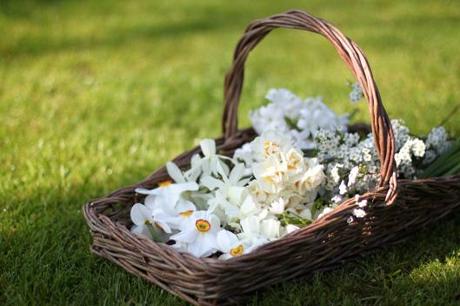
Yesterday I needed to make a posy of flowers for my mother to take to her local Women’s Institute meeting. After the exuberant tulip arrangement on Monday, I was ready for a contrast and took to my garden with my basket to collect some white narcissi. You can see above Pheasant’s Eye, White Cheerfulness and Thalia, all of which I have planted along the Woodland Walk and under the large trees in the centre of my garden. Daffodils (also called narcissi) are a bulb that look best planted in bulk in a natural setting. One of the many beauties of daffodil bulbs is that they naturalise once they are established in their setting, meaning increasing numbers of flowers as the years go by.
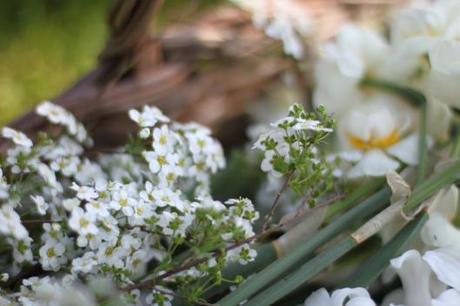
Stealing Chloris’s idea from In A Vase On Monday, I also picked some wafting stems of Spiraea Arguta to add an airy lightness to the display.
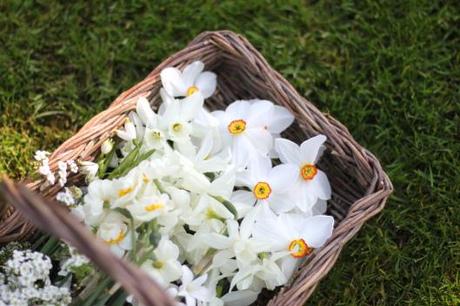
All of these varieties of white narcissi are bulbs that I have added to the garden since we moved here. I like to plant daffodils in clumps of 12 or 15, keeping single varieties together to create drifts. If you choose carefully from the bulb catalogues you can have daffodils in flower from very early in the year right through to May. My first daffodils were the King Alfreds flowering in late February this year, followed closely by the small delicate Tete a Tete and the wild narcissus pseudonarcissus.

Layered together in a small posy these narcissi made a highly scented arrangement. I used a tall thin vase to hold the stems and tied some of my favourite burlap ribbon around to add a natural texture. I have nearly used all of this ribbon which I bought in America last summer – I need to search online to see if I can find a replacement.
Cut daffodils leak a poisonous sap that can kill other flowers in an arrangement. If you want to use them in a mixed arrangement it is a good idea to stand them in a couple of changes of warm water before making your arrangement to allow the sap to flow out. I have also read that you can sear the stem over a candle flame, but I have not tried this method.
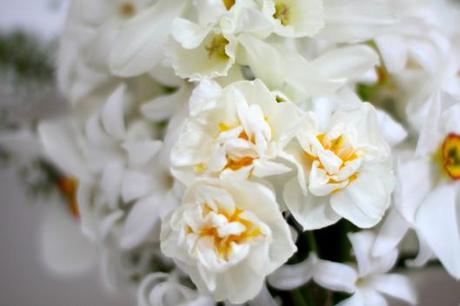
I particularly love these scented narcissi White Cheerfulness. I planted a large sack of these two years ago as an experiment and they have looked beautiful in clumps along the Woodland Walk since then. Daffodils are ordered in August or early September and need to be planted fairly quickly after arriving as the bulbs start to lose their vigour if you keep them for too long. I have planted daffodils as late as December, when I have found the odd forgotten bag lurking behind the tulips, but the flowers are never quite as good from a late planting.
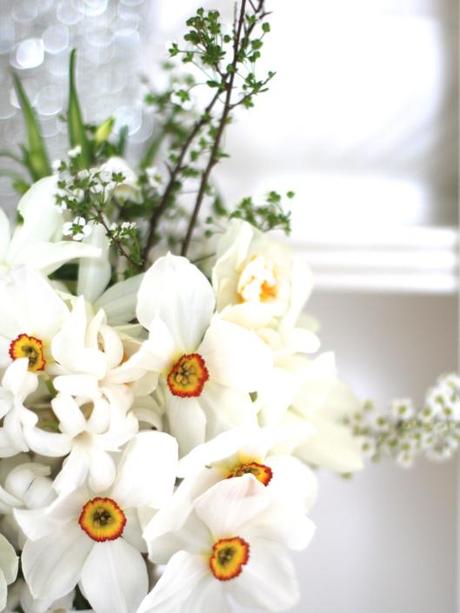
I prefer to see daffodils growing in a natural setting rather than in a flower bed. I am trying to increase my daffodils every year with extra plantings along the Woodland Walk and under the mature deciduous trees that grow in the centre of the garden.
After losing many tulips planted in the front garden, however, to rabbits and deer I have now changed tack in this area and am starting to plant daffodils in these beds for spring colour. The poisonous sap means that they are untouched by various wildlife, in contrast to tulips which make a tasty snack. My preferred variety to grow in beds is Thalia – there is something about the pale multi headed stems that allows Thalia to work in the more formal setting of a flower bed.
In contrast the Pheasants Eye narcissi above looks stunning in large clumps under the trees. Once the flowers go over I will leave the grass to grow long under the trees allowing the hidden bulbs to die back naturally.
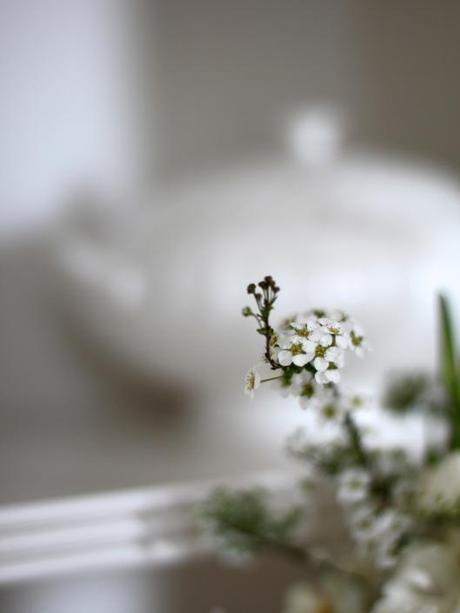
Spiraea Arguta is a favourite shrub of mine that I am hoping to have as a large mature specimen in a few years. At present I have three plants that I put in about three years ago. Two are in shaded positions and are establishing slowly. The third is in well drained soil in full sun and this seems to be the best situation. I make sure I prune all three back to strong buds soon after flowering as I have read that this will ensure a better display next spring. I am picking very carefully from this shrub as it is still quite small, but I hope in a year or two to be able to pick freely.
I am already thinking about autumn and what bulbs to order and where to plant them. To date I have not felt the need to plant any daffodils in the Cutting Garden. By building up large quantities to flower in the main garden I find I have enough that a bit of snipping for the house goes unnoticed.
This week I am beginning to feel like the child in a sweet shop; between drifts of the various daffodils and all my tulips flowering in the more formal settings, there is colour and excitement everywhere I look!
